Biathlon
Biathlon is a winter Olympic ski sport that combines cross-country skiing and rifle shooting. Biathlon is divided into male and female.
Contents
History of biathlon
It is commonly believed that biathlon originates from ski hunting, which is widespread among many northern peoples. Rock paintings, which are 5000 years old and were found in Norway, prove this fact.
In 1767, frontier guards on the Swedish-Norwegian border arranged competitions vaguely resembling biathlon for the first time. The participants had to go down the slope of mean steepness and hit a specific target at a distance of 40-50 steps using a rifle.
The first-ever "military patrol competition" – a sport that was very similar to modern biathlon – was held at the Winter Olympics in Chamonix in 1924.
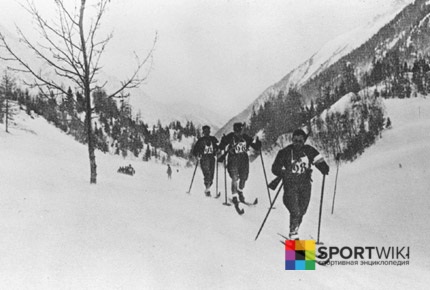
In 1954, the International Olympic Committee officially acknowledged biathlon to be a sport, and on November 17, 1956, the International Modern Pentathlon Union approved the rules for conducting modern biathlon competitions.
Biathlon Rules
Racers start upon command of a referee. Depending on the discipline, the start can be joint or individual (athletes start at set intervals). After covering a certain distance, athletes have to shoot targets. In case of missing targets, the athlete is penalized by covering the penalty loops or simply gets a penalty time.
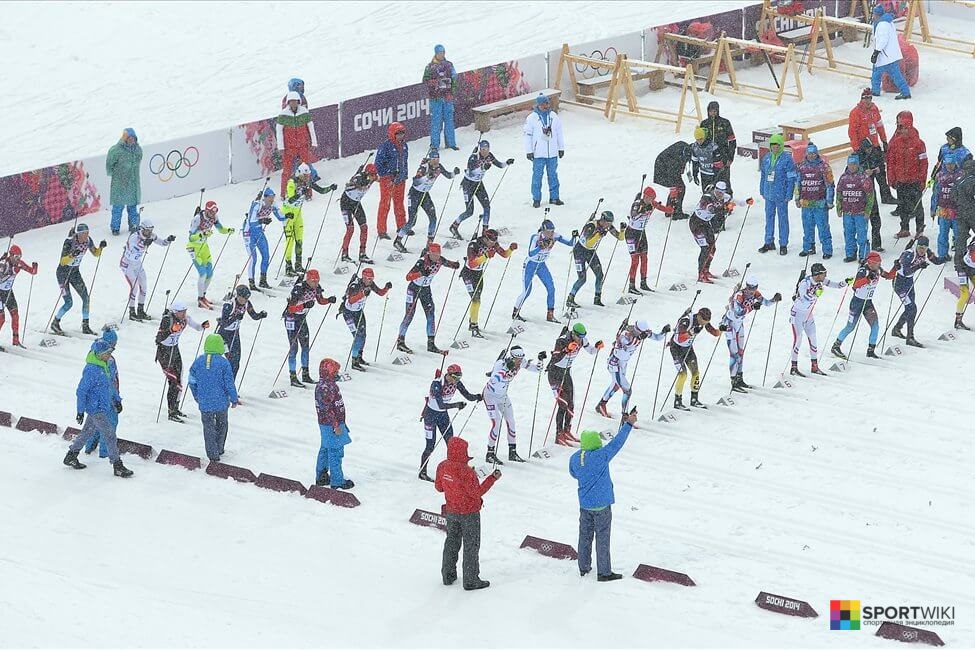
During the race, athletes are prohibited from taking shortcuts, ignoring penalty loops, and exerting intentional physical effects on other athletes.
The winner of the race is the biathlete who set the best time in the race.
Race Stages
The stage of the ski race is self-explanatory, it is no different from the usual ski race. Athletes use a free skiing style. Let’s dwell on the stage of shooting targets in more detail.
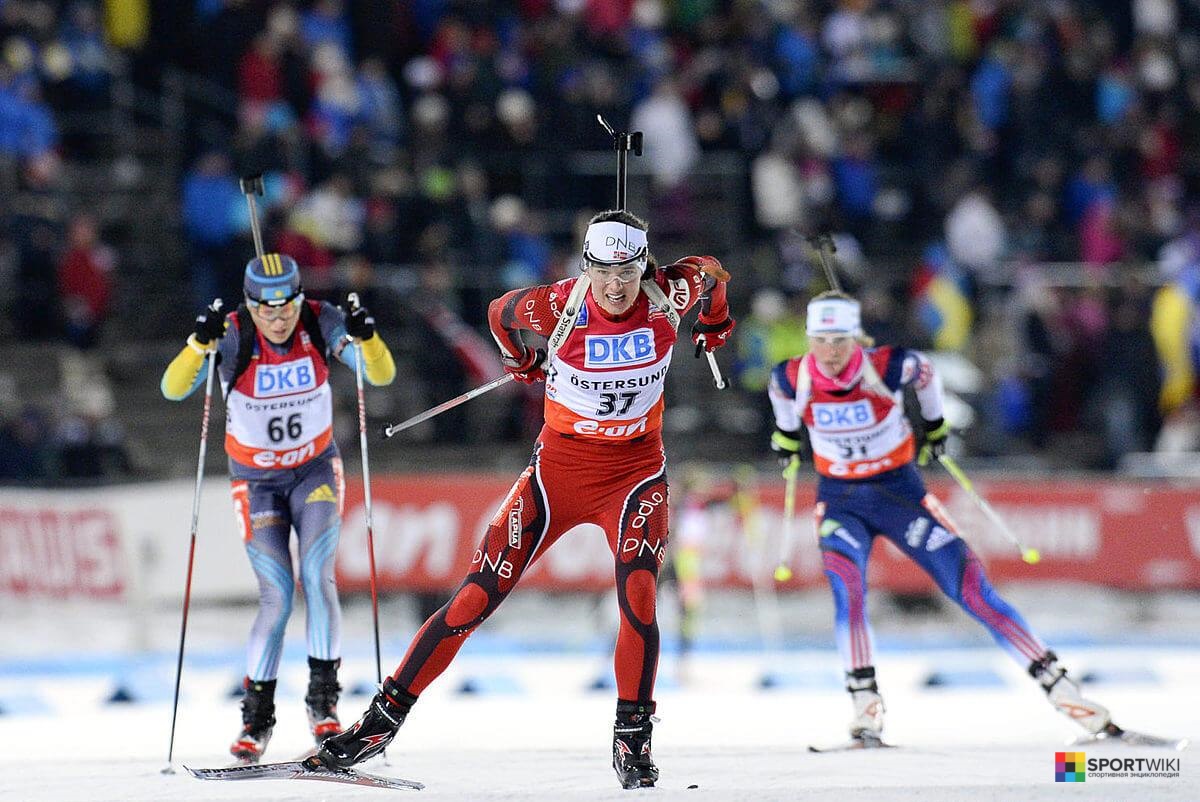
Depending on the race, athletes can occupy shooting lanes at their discretion (sprint or race) or strictly in order (pursuit, race, and sprint with a mass start), starting with the first free one. In the case of the mass start, at the first shooting stage, the athlete shoots from the shooting lane, the number of which corresponds to its start number. In the case of relay races, the shooting lane is determined by the start number of the team.
In all types of races, except the relay race, each biathlete has 5 shots at their disposal at each shooting stage. In the relay race, the biathlete can use 3 additional cartridges at each stage.
Shooting positions in biathlon
Prone position. When shooting in a prone position, athletes must follow the following rules: a rifle can only touch the athlete’s arms, shoulders, and cheeks. The inside of the hand (the palm) that holds the rifle must be raised from the ground surface (snow cover).
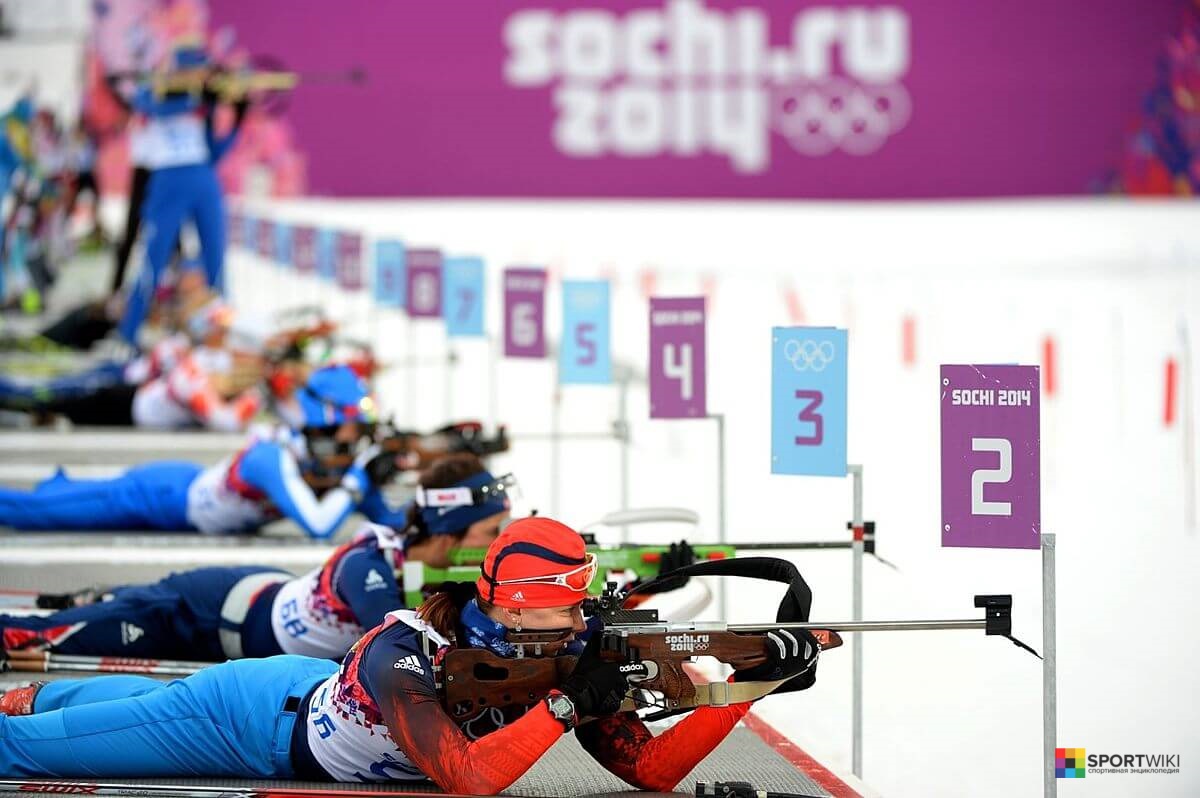
Standing position. Athletes stand without any support; only arms, shoulders, cheek, and chest (the side corresponding to the shoulder) can touch the rifle; the arm holding the rifle can rest against the chest or thigh.
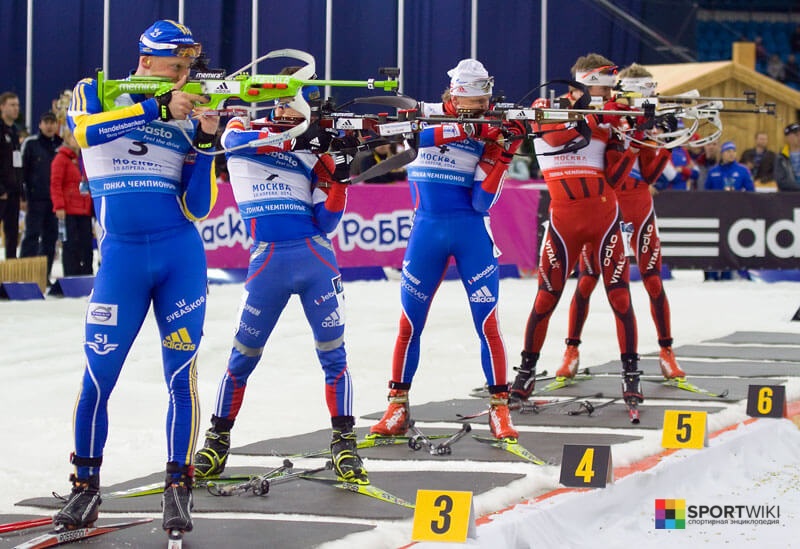
Track and shooting zone
The requirements for biathlon tracks are the same as the ones for regular ski race tracks:
- Biathlon competitions are held at the venues, which include the area of the central stadium, surrounded by a network of ski tracks. The stadium area usually includes a shooting zone, start and finish area, suitable for the mass start; 150-meter penalty loop, technical building, test area, team rooms for ski waxing, spectator area and the rest of the necessary infrastructure.
- Start and finish areas, shooting zone, penalty loop, and relay exchange zone must be located nearby, on the same level with a good competition viewing position for the majority of spectators. These areas and critical sections of the track must be fenced to prevent athletes from straying from the track during the competition and to protect non-participants from access. However, the height and number of fences must be minimized as much as possible so that it doesn’t interfere with organizing TV broadcasts.
- The starting line, which is perpendicular to the direction of the track, must be marked out in red.
- Starting tracks must be marked out with numbers according to their quantity. The number of markings must correspond to the number of teams participating in the race. The marking must be located to the left of each ski track and show the number on the front and back sides. The numbers on the markings must be at least 20 cm high and visible to athletes and television.
- A scoreboard with a diagram and profile of the track must be installed in the start area. A colored marking that shows the order, in which the competition track must be passed, must be located on the starting line.
- A start timer that is visible from the starting line must be located in the start area for individual and sprint races. A start timer must be located in each starting lane for a pursuit race. A timer that shows the current time of the day and is visible to athletes from this area must be located there as well or near the start area.
- The track must be marked in such a way that the athletes never doubt that they move in the right direction.
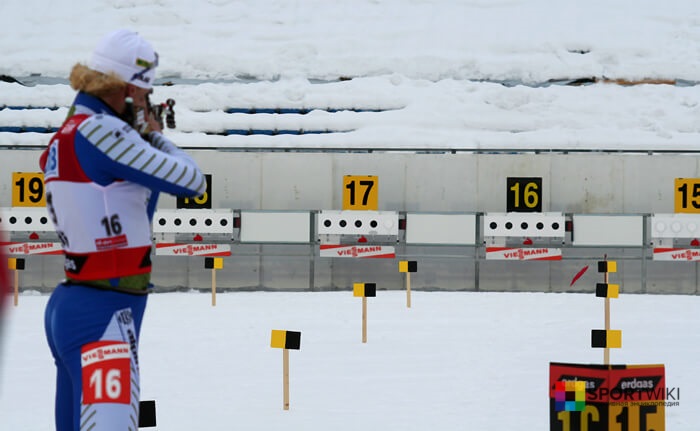
A shooting zone is a place where shooting is performed during biathlon training and competitions. It must be located in the central part of the stadium so that both the target and the shooting line are visible to most spectators. The shooting zone must be flat, horizontal and surrounded by safety banks on the sides and behind the targets. The location and equipment of the shooting zone must ensure safety on adjacent tracks, in the stadium area, and the surrounding area. The direction of fire (mainly to the north) must help create better lighting conditions during the competition. Safety equipment must not prevent spectators or television from watching the competition.
An area at least 25 m wide must be fenced off in front of the shooting zone for referees, technical staff and competitors. In finish and relay exchange areas, a food services area and warm changing rooms for each team must be equipped for the period of the competition.
A target in biathlon is a black circle in the recession of the plate, with a diameter of 115 mm. When shooting in standing position, hitting any section of the circle is scored, and when shooting in prone position – only hitting the black circle with a diameter of 45 mm, the center of which coincides with the center of the circle with a diameter of 115 mm, is considered to be scored.
Equipment of Biathlon
- The biathlon weapon is a small-caliber air rifle. The biathlon rifle is of 22 caliber and weighs no more than 3.5 kg. It is equipped with a trigger-locking mechanism, and reloading is done manually. Besides, clips are designed for only five cartridges.
- The biathlon skis. The minimum length of skis must be at least 4 centimeters less than the athlete’s height. Ski poles for biathletes are longer than the ones for ordinary skiers; as a rule, they are extended to the chin or mouth.
- A special one-piece suit that maintains body temperature and reduces wind resistance.
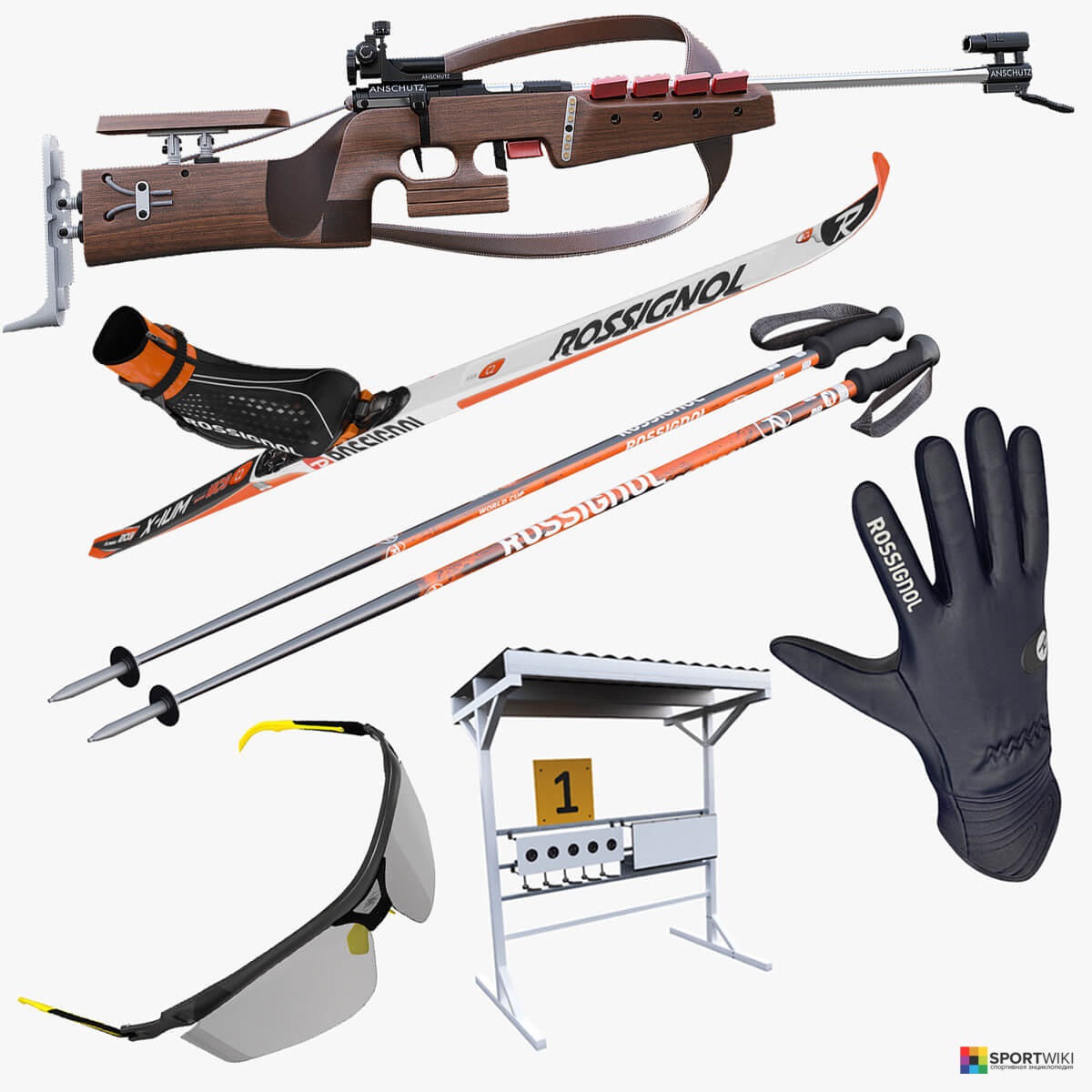
Types of races in biathlon
Sprint. In this discipline, the track is 10 km long for men, and 7.5 km long for women. Athletes must cover two shooting stages – one in standing position, and the other one in a prone position. If the biathletes miss, they must go to the penalty loop (which is 150 meters long). In this race, athletes run in turns. Sprint is the very first stage in biathlon competitions.
Pursuit. In this discipline, athletes start in the order, in which they finished the sprint. The track in the pursuit is 12.5 km long for men and 10 km long for women. In the pursuit (unlike the sprint), there are 4 shooting stages – 2 in a prone position and 2 in standing position.
Mass start. As the name implies, there is a mass start in this discipline. A distinctive feature of the mass start is the fact that the top 30 athletes in the current ranking of the year take part in this race. The mass start is 15 km long for men and 12.5 km long for women (with 4 shooting stages).
Individual race. This is the longest race in biathlon. The individual race is 20 km long for men and 15 km long for women (with 4 shooting stages). If athletes miss in this discipline, they get penalty minutes instead of penalty loops.
Relay. Teams of 4 athletes each take part in this race. Each of them passes their stage, which is 7.5 km long, and 2 shooting stages. It is important that if the athlete misses, they can use additional cartridges (3 pieces); reloading is done manually. Relay, like other types of biathlon, is held for men and women separately.
Biathlon cup competitions
- Biathlon World Cup. It consists of stages, each of which includes several male and female races. Competitions are held among men and women and include performances in the individual race, sprint, pursuit, mass start, relay, mixed relay, single mixed relay. Ranking of the best biathletes, both in individual disciplines and in the overall standings, is based on the results of the World Cup.
- Open European Cup (IBU Cup). As regards its importance and status, IBU Open European Championships is second only to the World Cup.
- North American Cup.
- South American Cup.
- Asian Cup.
Biathlon non-cup competitions:
- The Olympic Games are the most prestigious international biathlon competition.
- Biathlon World Championship is the largest international biathlon competition. As regards its prestige, it is second only to the Olympic Games.
- Open Biathlon European Championship.
- North American Championship.
- South American Championship.
- Asian Championship.
- Russian Biathlon Championship.
- Race of Champions is an annual commercial biathlon competition, which has been held in Russia since 2011.
World Team Challenge (which is better known as Christmas Biathlon Stars Race) should be mentioned when talking about commercial biathlon competitions.
Biathlon structures
International Biathlon Union (IBU) is an international biathlon federation, uniting national federations and other organizations representing biathlon. The headquarters of the union is located in Austria, in the city of Salzburg.

